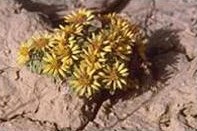
Gaillardia is a genus of flowering plants in the family Asteraceae, native to North and South America. It was named after Maître Gaillard de Charentonneau, an 18th-century French magistrate who was an enthusiastic botanist. The common name may refer to the resemblance of the inflorescence to the brightly patterned blankets made by Native Americans, or to the ability of wild taxa to blanket the ground with colonies. Many cultivars have been bred for ornamental use.

Gagea serotina, synonym Lloydia serotina, is an Arctic–alpine flowering plant of the lily family. It is widespread across the mountainous parts of western North America, from Alaska to New Mexico, and in Europe is found in the Alps and Carpathians, as well as in Great Britain. It is also native to much of Central Asia, Siberia, China, Nepal, Mongolia, Korea and Japan.

Echinacea purpurea, the eastern purple coneflower, purple coneflower, hedgehog coneflower, or echinacea, is a North American species of flowering plant in the family Asteraceae. It is native to parts of eastern North America and present to some extent in the wild in much of the eastern, southeastern and midwestern United States as well as in the Canadian Province of Ontario. It is most common in the Ozarks and in the Mississippi/Ohio Valley. Its habitats include dry open woods, prairies and barrens.

Heterotheca, are North American plants in the family Asteraceae.

Cirsium arizonicum, the Arizona thistle, is a North American species of thistle in the family Asteraceae, native to the southwestern United States and northwestern Mexico. It has been found in Arizona, southeastern California, New Mexico, Nevada, Colorado, Utah, Sonora, and northwestern Chihuahua.

Gutierrezia is a genus of flowering plants in the family Asteraceae, native to western North America and western South America. Plants of this genus are known generally as snakeweeds or matchweeds. Some species have been called greasewood. They are annual or perennial plants or subshrubs with yellow or white flowers.

Gutierrezia californica is a North American species of flowering plant in the family Asteraceae known by the common names San Joaquin snakeweed and California matchweed. It is native to California and Arizona in the United States and Baja California in Mexico. It grows in sunny sandy or rocky areas in grasslands, scrub, or open woodlands.

Gutierrezia microcephala is a species of flowering plant in the family Asteraceae known by the common names sticky snakeweed, threadleaf snakeweed, threadleaf broomweed, and smallhead snakeweed. It is a subshrub native to the southwestern United States and northern Mexico, and can be found in arid grassland and desert sand dune habitats. It can be toxic to livestock in large quantities, due to the presence of saponins and high concentrations of selenium.

Gutierrezia sarothrae is a species of flowering plant in the family Asteraceae known by the common names broom snakeweed, broomweed, snakeweed, and matchweed. It is a subshrub native to much of the western half of North America, from western Canada to northern Mexico, and can be found in a number of arid, grassland, and mountain habitats. It can be toxic to livestock in large quantities, due mainly to the presence of saponins.

Gutierrezia elegans, the Lone Mesa snakeweed, is a species of Gutierrezia endemic to the United States.
Carmenta haematica, the Argentine root borer, is a moth of the family Sesiidae. It was described by Ureta in 1956, and is known from Argentina and Chile.

Pediocactus bradyi is a very rare species of cactus known by the common names Brady's pincushion cactus, Brady's hedgehog cactus, and Marble Canyon cactus. It is endemic to Arizona in the USA, where it is restricted to Marble Canyon in Coconino County, though its exact distribution is not generally advertised due to poaching concerns. It is limited to a specific type of soil, it has a small distribution, and the species is threatened by a number of human activities. This has been a federally listed endangered species of the United States since 1979.

Townsendia aprica is a rare species of flowering plant in the family Asteraceae known by the common name Last Chance Townsend daisy. It is endemic to Utah in the United States, where it is known from three counties. It faces a number of threats and it is a federally listed threatened species of the United States.
Chrysothamnus molestus is a species of flowering plant in the family Asteraceae known by the common names Arizona rabbitbrush, Tusayan rabbitbrush, disturbed rabbitbrush, and stickyfruit low rabbitbrush. It is endemic to the State of Arizona in the southwestern United States, where it is known from Coconino, Apache, and Navajo Counties.
Broomweed is a common name for several species of plants, including:
Gutierrezia texana is a North American species of flowering plant in the family Asteraceae known by the common name Texas snakeweed. It is native to the south-central United States and northern Mexico as far south as Guanajuato and Hidalgo.

Greasewood is a common name shared by several plants:
Gutierrezia arizonica is a North American species of flowering plant in the family Asteraceae known by the common name Arizona snakeweed. It is native to Arizona in the United States and Sonora in northwestern Mexico.
Gutierrezia petradoria is a species of flowering plant in the family Asteraceae known by the common names San Pedro snakeweed and goldenrod snakeweed
Gutierrezia wrightii is a North American species of flowering plant in the family Asteraceae known by the common name Wright's snakeweed. It is native to the southwestern United States and northwestern Mexico.












